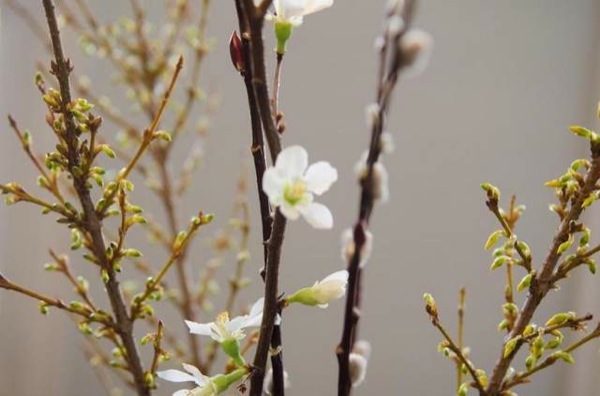
Native Delaware: Cold blooms
Winter weary gardeners can force branches for a taste of spring
1:17 p.m., Jan. 23, 2013--Many plant lovers need an early taste of spring to raise their winter-weary spirits.
Unfortunately, Mother Nature isn’t ready to oblige; the yellow blossoms of witch hazel and winter jasmine, both non-natives, won’t appear until mid- to late February. As for natives, serviceberry – one of the earliest native bloomers – won’t be out until early April.
Campus Stories
From graduates, faculty
Doctoral hooding
But gardeners can get that splash of color they crave now by forcing branches.
Most ornamental trees and shrubs set their flower buds during the previous season, notes Sue Barton ornamental horticultural specialist for University of Delaware Cooperative Extension. These buds must undergo a period of dormancy – usually about six weeks of cold temperatures – before they can bloom.
Gardeners can force forsythia, pussy willow, redbuds, crabapples and many other deciduous branches. But, keep in mind that since it’s only mid-January; not all species are ready to force.
Plants that gardeners should have luck with now include Cornelian cherry (a type of dogwood), forsythia, fothergilla and witch hazels. By the end of the month and into early February, they can start forcing cherries. By mid-February, a plethora of choices opens up – Eastern redbud, lilacs, magnolias, quinces, red maple and serviceberry.
However, these dates aren’t set in stone. What really matters is whether the flower buds have swollen. As soon as gardeners see signs that the buds are starting to expand, they can cut branches and bring them inside. Barton has a magnolia in her yard that already is showing buds. She plans to clip a branch or two to see if she can get it to flower inside now.
Throughout the winter months, Barton keeps an arrangement of forced branches on a stainless steel bar that divides her kitchen from her family room. “I want the flowers to be the first thing you see when you come in the front door,” she says. “If I have an arrangement on the dining room table for a dinner party, I always move it to the kitchen after the party is over. Keep spring blooms out in a spot where you’ll see them often.”
Dare to be different and try something unexpected. Like red maple, suggests Barton.
“Red maple blooms are some of my favorite for forcing,” she says. “Out in the landscape, on a large tree, the budding flowers may not look all that spectacular. But when you have just a few branches inside, in a vase, you can really appreciate the clusters of tiny red flowers and long stamens on this native species.”
Blooms aren’t the only thing that helps Barton banish the winter blahs. She also cuts branches with catkins, from willows (pussy willows are very easy to force), as well as from beeches and birches.
She likes to force leaves, too.
“I often force beech buds,” she says. “Beech buds are pointy and when the leaves unfurl, the pleated leaves look as pretty as any flower.”
People should take time cutting and choosing their branches, even if the cold winds are blowing and they’re anxious to get back inside.
“Remember that you are changing the shape and look of your bush, so try not to take all your branches from the same side of the bush,” advises Anne Boyd, a Master Gardener with New Castle County Cooperative Extension.
“Select long, thin branches that have buds on them and cut them off near a junction,” she says. “Once you are back inside you can look them over and trim any that are too long or too branched.”
Not long after the holiday decorations have been taken down at Hagley Museum, staff horticulturalist Renee Huber starts cutting branches to brighten the Visitors Center, Belin House café and other public areas.
“Bringing in a handful of branches and watching them progress with either leaves or beautiful blossoms really gives you hope that spring will come,” says Huber.
After she cuts the branches, she puts them in warm water in a spot out of direct sun. She likes to add a bit of bleach to the water – around one tablespoon per gallon – to control bacteria.
Eileen Boyle, who also is a horticulturalist at Hagley, prefers to place branches in a garage, cellar or other cool, dark spot overnight after she has cut them for forcing. Then, on day two, she re-cuts the stems and places the branches in tepid water.
“Keep an eye on water level, changing the water daily,” she says.
Depending on the plant, buds need up to two weeks before they’ll bloom. Cherries may start flowering in just a few days; forsythia is another quick bloomer.
For those who don’t see any blooms after two weeks, they goofed. They may have cut the branches too early before the buds were properly formed or they may not have kept the water clean enough and bacteria rotted the opening of the stem. Perhaps the water level wasn’t adequate. Or, if the vase was in too hot of an area, the flowers may have opened but not fully or they faded fast.
But this kind of gardening goof is easy to fix. “Just go out and cut some more branches and try again,” says Barton.
Article by Margo McDonough
Photo by Danielle Quigley








